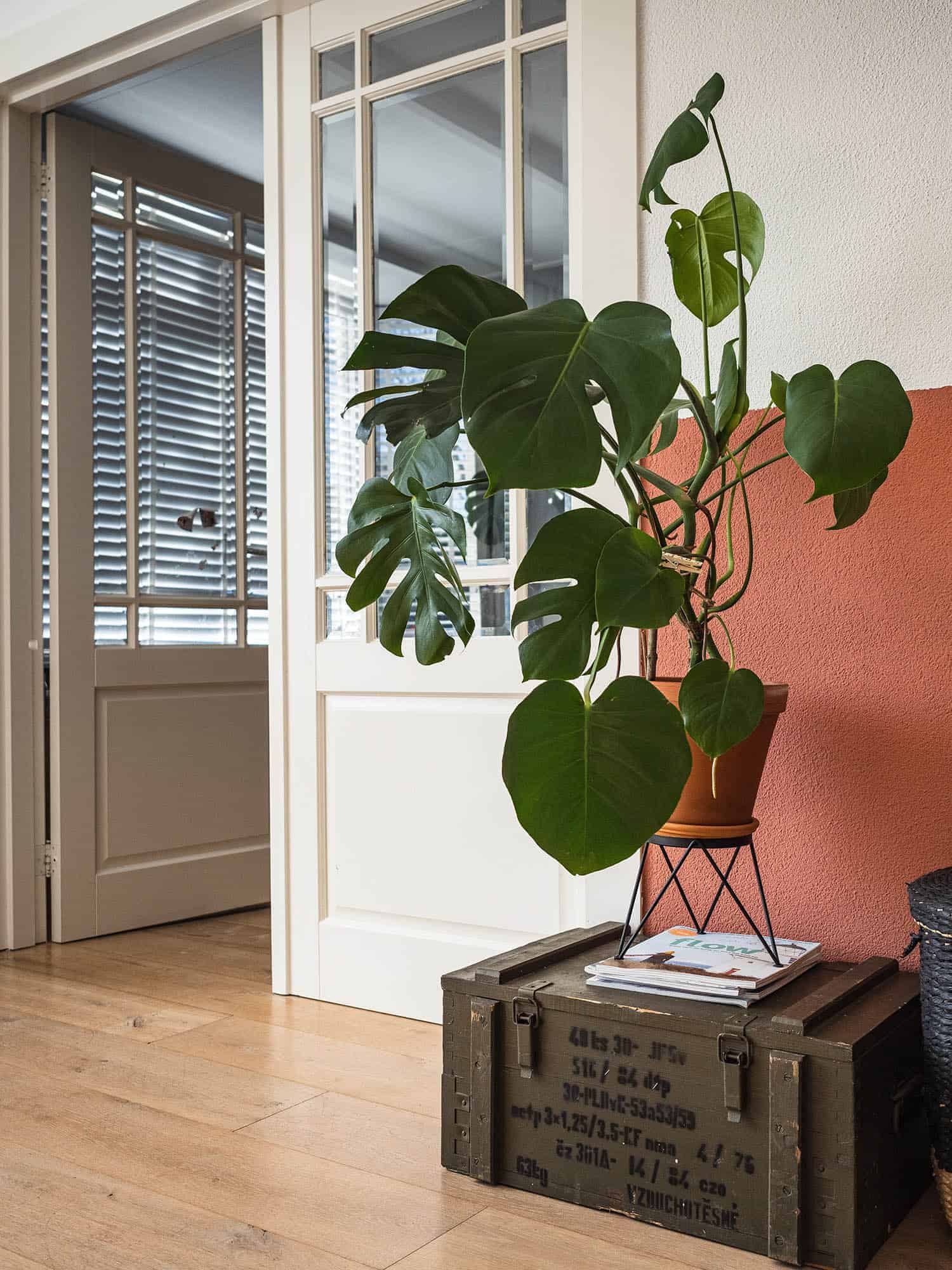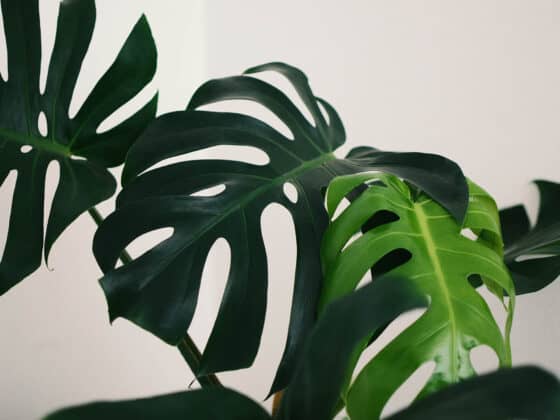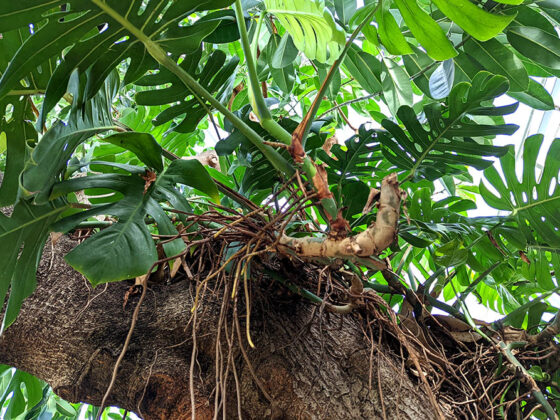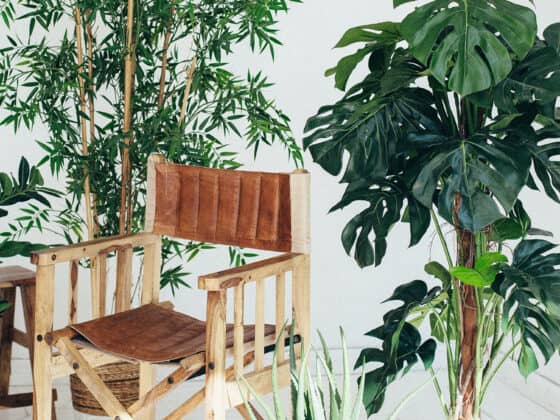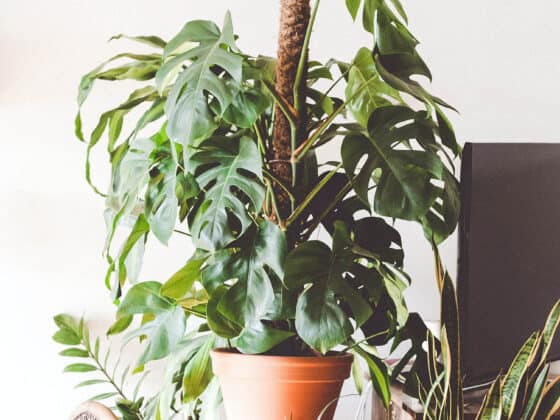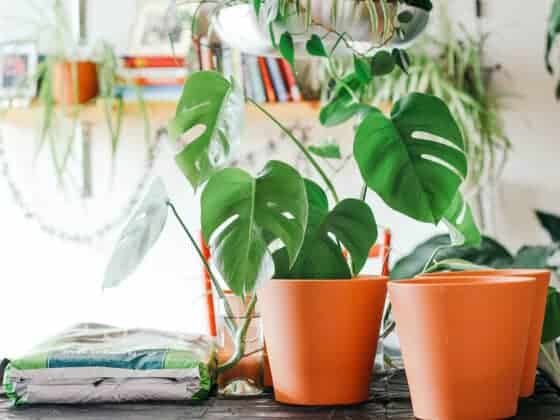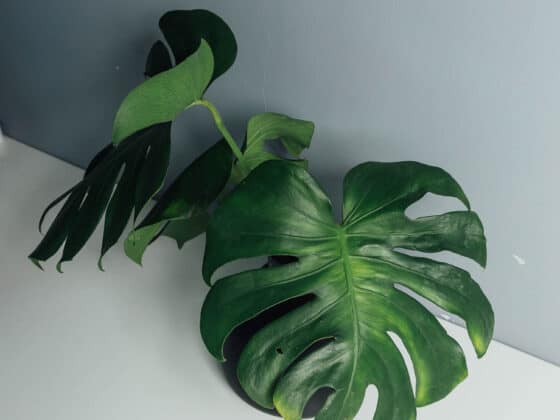We’ve all seen the photos on Instagram of the insanely huge Monstera Deliciosa that seems to take over a room. While that can be inspiring, not everyone wants or has the space for a plant that truly lives up to its monster name. If you’re hoping to keep your Monstera at a more manageable size, what does that take?
Can you keep a Monstera small? Yes, though it is a bit of an uphill battle. These quick-growing plants can be encouraged to stay smaller by limiting their exposure to light, pruning back leaves, stems, and roots, and choosing not to repot the plant. But ultimately, they will still grow at a speedy rate.
Many people turn to the internet to figure out how to grow the largest Monstera possible, but if that’s not you, that’s okay too. Small Monsteras can still become focal points of any room without overtaking the space. Keep reading to learn more about ways to keep your Monstera Deliciosa small, why you should prune them, and what you can do with the cuttings that are leftover.
What to Expect From Your Monstera Deliciosa
In their natural habitats, a Monstera Deliciosa can reach over 60 feet tall as they grow up the trunks of established trees. These vining plants thrive in moist, humid environments and grow so quickly that they have become an invasive species in Hawaii. This rapid growth is the result of the plant’s exposure to ideal conditions, which are difficult to emulate in the home.
Kept indoors and in nearly perfect conditions, a well-loved Monstera Deliciosa can reach up to 8 feet tall with leaves up to two feet across. And while not as quick as in the wild, indoor Monsteras still grow fast.
Monsteras can grow one new leaf per growth point (node) each month, which can turn into a lot if you have an older plant with multiple growth points. But this rapid rate is dependent on the environment the plant resides in.
Can You Keep a Monstera Deliciosa Small?
While they can be kept small, Monsteras need to be regularly attended to. These plants prefer moist, humid, and well-lit environments, so limiting any of those factors can help to keep a Monstera small. But it is extremely important to do this carefully. Neglecting your plant can cause serious harm and could even result in its death.
The goal is to keep your plant in nearly ideal conditions. This will stunt their growth but still keep them healthy. We’re looking for a happy medium here.
Tip #1: Limit Your Monstera’s Access to Sunlight
While it might seem cruel to keep a sun-loving plant from getting the amount of light it needs to grow quickly, this is one of the easiest ways to keep a Monstera from outgrowing its environment.
When kept indoors, Monsteras prefer bright, indirect sunlight. They can tolerate some direct sunlight, but it is generally not recommended and can result in leaf yellowing.
If you have kept your Monstera Deliciosa in a part of your home that meets these light requirements and it is growing beyond what you can handle, try moving it further from the window or into a slightly darker room. But do make sure it is still getting enough light to survive. Failing to do so can ultimately stunt growth and potentially kill the plant.
Indications that your plant is getting too little sunlight include small and sparse discolored leaves, a lack of fenestrations in the new growth of an established plant, and soil that stays moist for too long. Be sure to watch for these signs to prevent any permanent damage to your Monstera.
Tip #2: Prune Your Monstera Deliciosa
Pruning is vital to nearly all plants. It keeps them from growing overwhelmingly, allows them to focus on healthy parts, and encourages new growth. While anything that encourages new growth may sound counterproductive to keeping a Monstera small, pruning is still important for the overall health of your plant. A good pruning will keep your Monstera happy and manageable.
To get started, you’ll need a pair of sharp scissors or shears. It is essential to sterilize the clippers before cutting to make sure you don’t introduce bacteria into any of the cuts. I use a diluted bleach solution of one part bleach to 9 parts water to clean my shears.
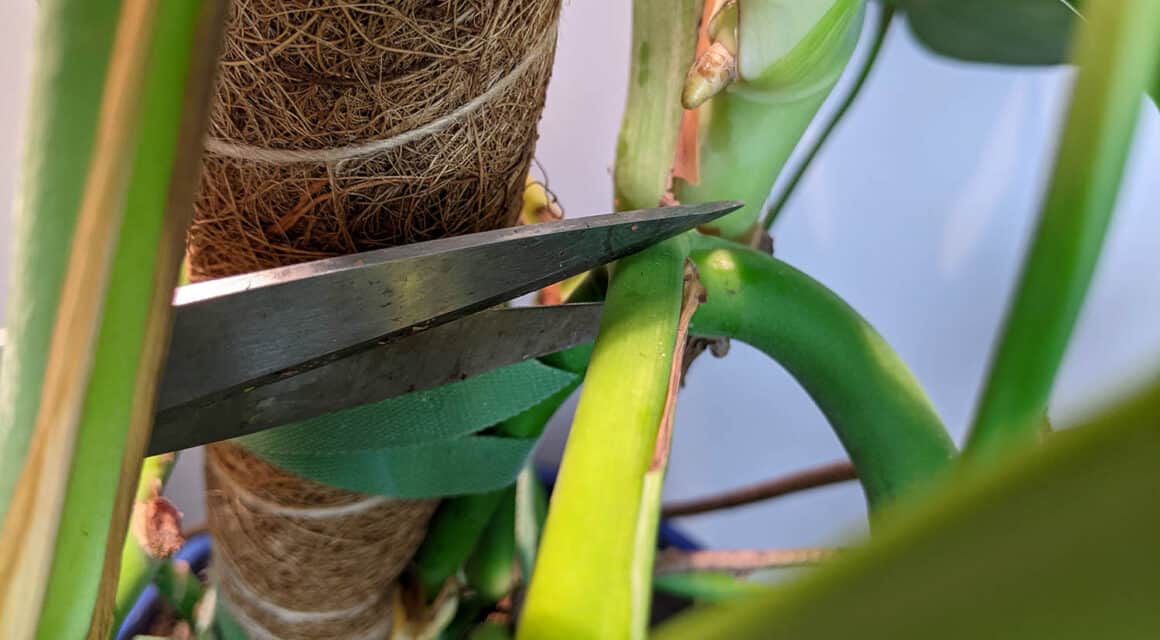
Try to plan out what you want to cut before you start chopping up your plant, keeping in mind how each cut will affect the plant’s overall look. Start by removing old yellow or brown leaves and then move on to healthy portions that are reaching out a bit too far for your liking. You can clip back individual leaves to the stem or even bits of the stem itself.
Monstera roots can also be pruned to discourage the plant from exceeding a size you can easily care for. Using your sterilized shears, remove the plant from its pot and cut back no more than one-third of the roots. For more information on pruning back Monsteras, read this article.
Tip #3: Keep Your Monstera Deliciosa in a Small Pot
Preventing your Monstera from having the space to grow will keep it from continuing to get bigger. Most plants should be repotted a size up every year. If your goal is to keep your Monstera small, you should avoid this.
On the flip side, it’s important to note that having a root-bound Monstera Deliciosa isn’t a good thing either. Root-bound plants cannot absorb water or nutrients properly, which can hurt the plant’s development. That’s why it’s essential to prune back the plant’s roots if you’re going to keep it in the same pot year after year.
Despite not repotting into a larger pot, you should still plan to refresh the soil about once a year. This will give your Monstera fresh nutrients and allow you to see how its roots are doing.
The Best Time to Cut Back Monsteras
Pruning can be done all year long, but any significant cuts should be reserved for the early spring, preferably before the growing season starts. Monsteras experience more growth in the spring and summer, so cutting before this starts will encourage the plant to heal quickly.
Pruning during the early spring will also encourage your Monstera to grow new stems, so keep that in mind when cutting to maintain size. While that can seem counterintuitive, new growth can always be pruned back or used to start new plants.
Throughout the year, if you notice new growth in an area that has just been pruned, cut it back while it is still small. Cutting small pieces of the plant isn’t a major operation, so the plant should have no problem healing the area. This will also make your primary pruning sessions much easier.
Propagate What You Prune
While it isn’t unique to the Monstera Deliciosa, these plants respond very well to propagation. This can be done with the cuttings that would otherwise be thrown away after pruning.
If you plan to propagate your Monstera cuttings, make your cuts just beneath a node. These are generally found towards the stem, near the base of the plant, and will often have aerial roots growing from them. Cutting here encourages the new plant to root.
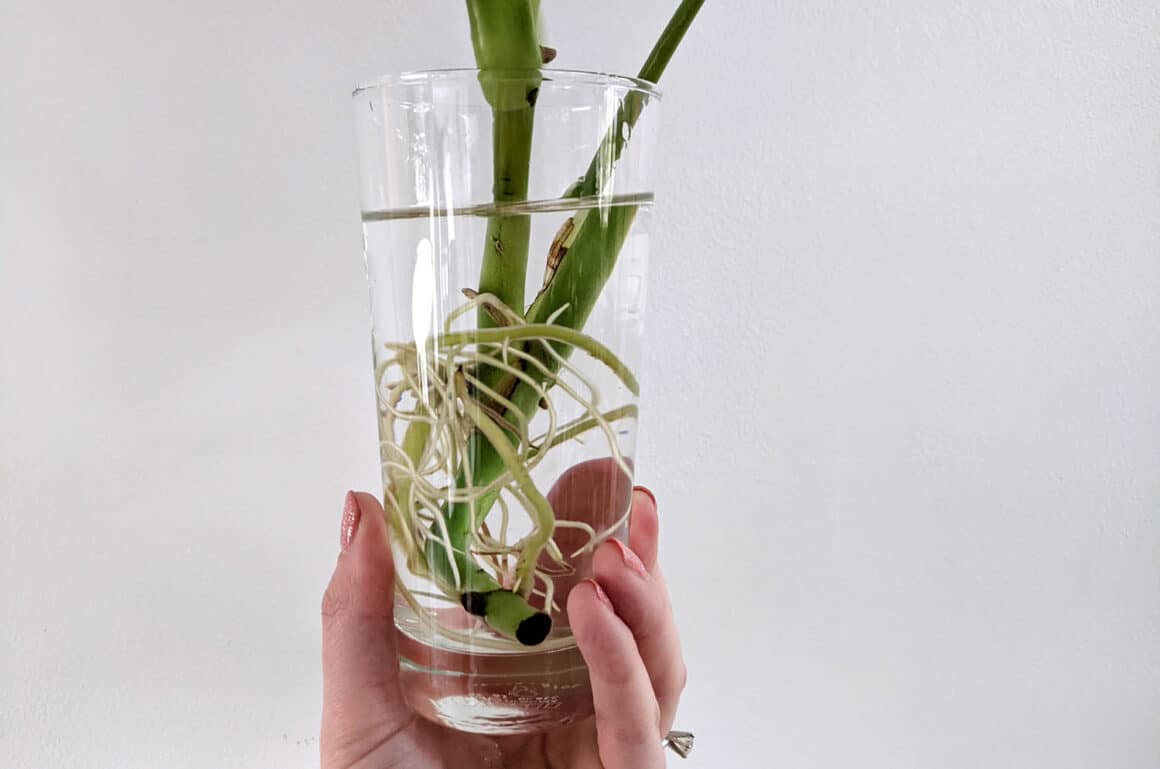
Monsteras can be propagated in both soil and water. I prefer propagating cuttings in water because I prefer how it looks, and root growth is easier to track. But some plant enthusiasts believe that this puts the plant at a disadvantage. Soil propagation generally develops sturdier root systems, but I’ve had excellent results with both options.
Once put into their growing medium, they should be placed in a warm and bright spot similar to what an established plant would need. Cuttings taken in the winter months will take much longer to root, so you’ll need to be patient if this is the case.
To find more information on taking the best cuttings from your Monstera Deliciosa, read this article.
Final Thoughts on Keeping a Monstera Deliciosa Small
Keeping your Monstera Deliciosa small isn’t difficult. Plenty of well-intentioned plant owners do this accidentally by providing less than ideal conditions, and their plants continue to live happily. It’s important to keep in mind that Monsteras do grow rapidly, so this could be an uphill battle.
Always watch your Monstera for any indication that it is unhappy or isn’t responding well to a change in its environment. Moving it from one area to another might elicit a negative response, so make sure you are accommodating to your plant. Watch for drooping and changing leaves—these are good indicators that something is wrong.
Pruning is an excellent opportunity to propagate your Monstera, so don’t waste those cuttings! Even if you don’t intend to fill your house with Monsteras, the leaves look beautiful when displayed in a glass jar or vase.






